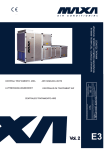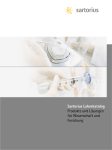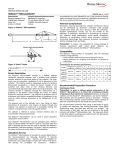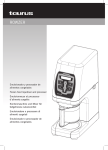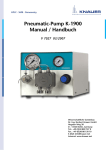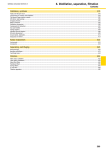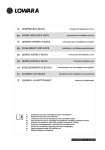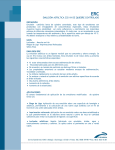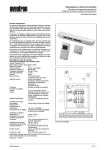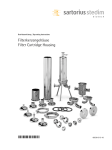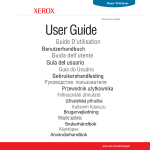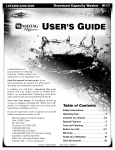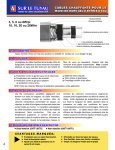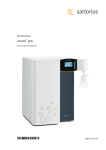Download Sartolab-P20 | Sartolab
Transcript
Directions for Use | Gebrauchsanleitung | Instruction d’utilisation Instrucciones para el uso | Istruzioni per l’uso Sartolab®-P20 | Sartolab®-P20 plus 83052-000-50 Contents 1. Product Description and Applications 1. Product Description and Applications 2. Ordering Information 3. Notes 4. Specifications for Sartolab P20 5. Specifications for Sartolab P20 Plus 6. Directions for Use 7. Chemical Compatibility The Sartolab P20 and Sartolab P20 Plus ready-to-use filtration units, for single use only, are delivered sterile and individually packaged. They have been developed for fast, biocompatible sterile filtration of aqueous solutions and media containing serum. A surfactant-free cellulose acetate membrane with very low non-specific protein binding characteristics is sealed in a polycarbonate housing. The combination of the hydrophobic PTFE membrane for automatic venting and the hydrophilic cellulose acetate membrane results in a very high flow rate during filtration. The glass fiber prefilter (which is 100% free of binding agents) incorporated in the Sartolab P20 Plus may even double the total filtration volume. 2| 2. Ordering Information The units are available in various configurations: with either a hose nipple (barb) or luer lock as the inlet connector. The order numbers for a package of 10 units are listed below: Sartolab® P20 and Sartolab® P20 Plus Order number Cellulose acetate membrane 0.2 μm Glass fiber prefilter Filling bell Hose nipple inlet Luer Lock inlet Hose nipple outlet Sartolab P20 18052D 18053D + + + + + + + + Sartolab P20 plus 18056D 18058D + + + + + + + + + + 3. Notes – The Sartolab P units are constructed so that filtration may only be performed in one direction. The inlet side is labeled “IN“ and has eight vent openings arranged around the inner circle. The outlet side is labeled “OUT.” – When handling the units, make sure to prevent contamination of the filtrate outlet, or the mounted filling bell. – If the filtrate flow rate drops below the required rate (the filter is blocked), replace the Sartolab P with a new one. – Sartolab P units are for single use only – do not re-use them. |3 4. Specifications for the Sartolab P20 Order numbers Housing material Filter material Filter diameter Filtration area Hold-up volume before bubble point Connector: inlet Connector: outlet Flow direction Housing burst pressure Bubble point Max. recommended inlet pressure Flow rate for water Filtration range 18052D, 18053D Polycarbonate Surfactant-free cellulose acetate 0.2 μm pore size 64 mm 20 cm2 1 ml Female luer lock or stepped hose nipple with 6–12 mm outer diameter Hose nipple (see above) Unidirectional > 5 bar (72 psi) > 3.2 bar (46 psi)* 3 bar (43 psi) 300 ml/min at Δp = 1 bar (14.5 psi) 100 ml – max. 5 l 5. Specifications for the Sartolab P20 Plus Order numbers Housing material Filter material Filter diameter Filtration area Hold-up volume before bubble point Connector: inlet Connector: outlet Flow direction Housing burst pressure Bubble point Max. recommended inlet pressure Flow rate for water Filtration range 18056D, 18058D Polycarbonate Surfactant-free cellulose acetate, 0.2 μm pore size Glass fiber, 100% free of binding agents 64 mm 20 cm2 Approx. 1.5 ml Female luer lock or stepped hose nipple with 6–12 mm outlet diameter Hose nipple (see above) Unidirectional > 5 bar (72 psi) > 3.2 bar (46 psi)* 3 bar (43 psi) 300 ml/min at Δp = 1 bar (14.5 psi) 100 ml – max. 10 l * > 3.1 bar when measured with an automatic integrity tester 4| 6. Directions for Use 6.1. The Sartolab P20 and Sartolab P20 Plus are pressure filtration units. The liquid to be filtered can be supplied via a pressure tank or a peristaltic pump. Especially for this range of applications, we offer a self-regulating diaphragm pump with electronic speed control and a set of connecting hoses for the Sartolab P20 units (18059). Please read the operating instructions provided with the pump. 6.2. After you have set up the pressure source and filtrate receptacle, remove a Sartolab P20 unit from the box and make sure that the packaging is not damaged. 6.3. Make sure that the inlet side of the pressure filtration unit is located below the seam for opening the package (marked with a “Y”). The inlet side can be identified by the eight vent openings arranged around the inner circle (see Figure 1). The sides of the unit are also labeled “IN” = inlet and “OUT” = outlet. If you have ordered Sartolab P20/Sartolab P20 Plus with a filling bell, it is on the outlet side. Once you have properly positioned the unit, tear open the packaging at the designated seam (see Figure 2). 6.6. Remove the lid from the filling bell before beginning filtration. 6.7. Start filtration by slowly increasing the applied pressure. The entrapped air escapes through the PTFE membrane by automatic venting. As soon as the cellulose acetate membrane has completely wetted out, you can increase the inlet pressure up to 3 bar. 6.8. After the filtration run has been completed, you can check the integrity of the filter by connecting a pressure source to the unit. Adjust the inlet pressure to a constant 3.0 bar (300 kPa or 44 psi) and hold the Sartolab filtration unit under water in a beaker. If the filter is intact, no air bubbles should escape from the outlet (downstream) side. Air bubbles that escape through the automatic vents on the upper part do not have any effect on the integrity of the surfactant-free cellulose acetate membrane. 6.9. After completing filtration, discard the filtration unit. If applicable, follow the current regulations for radioactive or infectious material. 6.4. Connect the hose from your pressure source to the inlet side of the Sartolab P20/ Sartolab P20 Plus (luer lock connector or stepped hose nipple) without taking the sterile side out of the packaging. Check that the hose is connected tightly enough to withstand the pressure applied. 6.5. Without touching the sterile side, remove the filtration unit from the packaging and mount the unit above the filtrate receptacle, for instance, using a stand (see Figure 3). |5 Caution 7. Chemical Compatibility When filtering solutions containing surface-active substances (organic solvent components, alcohols), the water penetration pressure of the PTFE membrane may decrease so much that liquid seeps out of the automatic vents. If necessary, rinse these substances out of the PTFE membrane first, then dry the unit in a drying oven overnight at 105°C. As mentioned above, the Sartolab P20/ Sartolab P20 Plus is designed for filtration of aqueous solutions – not for organic solvents, alcohols, acetone, surfactants (emulgators), strong acids or bases. For such purposes, we recommend the Sartorius Stedim Biotech Midisart 2000 units, containing a PTFE membrane, order no. 17804E (0.45 μm pore size) or 17805E (0.2 μm pore size). Avoid unnecessary air intake during the filtration by ensuring, for example, that the inlet end of the intake tubing is kept below the surface of the liquid being filtered. Otherwise, particularly when using Sartolab P20 Plus, a pocket of air may build up above the membrane, resulting in partial or complete “blocking“ of the membrane. Should this occur, however, pump all of your solution out of the system first, then continue the filtration run as described in step 6.7. In the interest of the further development of Sartorius Stedim Biotech products, we reserve the right to make changes to the design or specifications without notice. 6| Inhaltsverzeichnis 1. Produktbeschreibung und Anwendungen 1. Produktbeschreibung und Anwendungen 2. Bestellhinweise 3. Bemerkungen 4. Technische Daten Sartolab-P20 5. Technische Daten Sartolab-P20 plus 6. Gebrauchsanleitung 7. Chemische Beständigkeit Der Sartolab-P20 und der Sartolab-P20 plus sind gebrauchsfertige Einmal-Filtrationseinheiten, die steril und einzeln verpackt geliefert werden. Sie sind zur schnellen und biokompatiblen Sterilfiltration von wässrigen Lösungen und serumhaltigen Medien entwickelt worden. Eine netzmittelfreie Celluloseacetat-Membran mit einer sehr geringen unspezifischen Proteinadsorption ist in ein Polycarbonatgehäuse eingeschweißt. Die automatische Entlüftung durch eine hydrophobe PTFE-Membran bewirkt in Kombination mit der hydrophilen Celluloseacetat-Membran eine sehr hohe Flussrate bei der Filtration. Durch den integrierten 100% bindemittelfreien Glasfaservorfilter beim Sartolab-P20 plus kann sich das Gesamtfiltrationsvolumen oft sogar verdoppeln. |7 2. Bestellhinweise Die Einheiten sind in verschiedenen Ausführungen lieferbar:mit Schlaucholive oder Luer Lock als Eingangsanschluss. Die Bestellnummern für Packungen à 10 Stück sind wie folgt: Sartolab-P20 und Sartolab-P20 plus Sartolab P20 Bestellnummer 18052D CelluloseacetatMembran 0,2 μm + Glasfaser Vorfilter Füllglocke + Eingang Schlaucholive + Eingang Luer Lock Ausgang Schlaucholive + 18053D + + Sartolab P20 plus 18056D 18058D + + + + + + + + + + + + 3. Bemerkungen – Die Sartolab-P Einheiten sind so konstruiert, dass eine Filtration nur in eine Richtung durchgeführt werden darf. Die Eingangsseite ist mit acht kreisförmig angeordneten Entlüftungsöffnungen versehen und mit »IN« gekennzeichnet. Die Ausgangsseite ist mit »OUT« gegekennzeichnet. – Während der Handhabung ist darauf zu achten, dass Kontaminationen des Filtratausganges bzw. der angebrachten Füllglocke vermieden werden. – Sartolab-P Einheiten sind für den einmaligen Gebrauch bestimmt. Sie dürfen nicht mehrfach verwendet werden. 8| 4. Technische Daten Sartolab-P20 Bestellnummern Gehäusematerial Filtermaterial Filterdurchmesser Filtrationsfläche Totvolumen vor Bubble Point Anschluss: Eingang Anschluss: Ausgang Flussrichtung Gehäuseberstdruck Bubble Point empfohlener Eingangsdruck Durchflussleistung für Wasser Filtrationsbereich 18052D, 18053D Polycarbonat Celluloseacetat, netzmittelfrei, 0,2 μm Porengröße 64 mm 20 cm2 1 ml Luer Lock Innenkegel oder Stufenolive mit 6–12 mm Außendurchmesser Schlaucholive (s.o.) unidirektional > 5 bar > 3,2 bar* max. 3 bar 300 ml/min bei Δp = 1 bar 100 ml – max. 5 l 5. Technische Daten Sartolab-P20 plus Bestellnummern Gehäusematerial Filtermaterial Filterdurchmesser Filtrationsfläche Totvolumen vor Bubble Point Anschluss: Eingang Anschluss: Ausgang Flussrichtung Gehäuseberstdruck Bubble Point empfohlener Eingangsdruck Durchflussleistung für Wasser Filtrationsbereich 18056D, 18058D Polycarbonat Celluloseacetat, netzmittelfrei 0,2 μm Porengröße 100 % bindemittelfreie Glasfaser 64 mm 20 cm2 ca. 1,5 ml Luer Lock Innenkegel oder Stufenolive mit 6–12 mm Außendurchmesser Schlaucholive (s.o.) unidirektional > 5 bar > 3,2 bar* max. 3 bar 300 ml/min bei Δp = 1 bar 100 ml – max. 10 l * > 3,1 bar wenn mit einem automatischen Integritätstestgerät gemessen wird |9 6. Gebrauchsanleitung 6.1. Der Sartolab-P20 bzw. Sartolab-P20 plus ist eine Druckfiltrationseinheit und die Flüssigkeitszufuhr kann über einen Druckbehälter oder einer Peristaltikpumpe erfolgen. Wir bieten speziell für diesen Anwendungsbereich eine selbstregulierende Membranpumpe mit elektronischer Drehzahlregelung und einem Anschluss-Schlauchset für die Sartolab-P20 Einheiten an (18059). Beachten Sie bitte ebenfalls die Bedienungsanleitung der von Ihnen gewählten Pumpe. 6.2. Entnehmen Sie nach der Vorbereitung der Druckquelle und des Gefäßes für das Filtrat eine Sartolab-P20 Einheit aus dem Karton und stellen Sie fest, ob die Verpackung unversehrt ist. 6.3. Kontrollieren Sie, ob sich die Eingangsseite der Druckfiltrationseinheit unterhalb der vorgegebenen Reißnaht befindet. Die Eingangsseite ist an den acht im Innenkreis angeordneten Entlüftungslöchern erkennbar (s. Abb.1). Die Einheit ist weiterhin mit erhabenen Buchstaben mit »IN« = Eingang und »OUT« = Ausgang beschriftet. Im Falle einer Bestellung von Sartolab-P20/Sartolab-P20 plus mit Füllglocke befindet sich diese auf der Ausgangsseite. Sobald die Einheit richtig orientiert ist, reißen Sie die Verpackung an der vorgegebenen Naht auf (s. Abb.2). 6.4. Adaptieren Sie den Schlauch von Ihrer Druckquelle mit der Eingangsseite des Sartolab-P20/Sartolab-P20 plus, ohne dass Sie die Sterilseite aus der Verpackung entfernen (Lock Anschluss oder die konische Stufenschlaucholive mit einem Außendurchmesser 6 –12 mm). Achten Sei bei der Adaptation an ein Fremdsystem darauf, dass die Schläuche druckfest angebracht sind. 10 | 6.5. Entnehmen Sie jetzt, ohne die Sterilseite zu berühren, die Filtrationseinheit der Verpackung und fixieren Sie diese oberhalb des vorgesehenen Filtratgefäßes, z.B. an einem Stativ (s. Abb.3). 6.6. Falls Sie eine Einheit mit Füllglocke verwenden, entfernen Sie bitte vor Beginn der Filtration den Deckel der Füllglocke. 6.7. Beginnen Sie mit der Filtration, indem Sie langsam den angelegten Druck steigern. Die eingeschlossene Luft entweicht hierbei durch die PTFE-Membran der automatischen Entlüftung. Sobald die CelluloseacetatMembran vollständig benetzt ist, können Sie den Eingangsdruck bis zu 3 bar erhöhen. 6.8. Nach der Filtration lässt sich die Integrität des Filters mit einer Druckquelle überprüfen. Dazu einen konstanten Druck von 3,0 bar einstellen und die Filtrationseinheit in ein Becherglas unter Wasser halten. Es dürfen keine Luftblasen auf der Ausgangsseite austreten! Luftblasen, die am Oberteil durch die automatische Entlüftung austreten, haben keine Beeinträchtigung auf die Integrität der netzmittelfreien CA-Membran. 6.9. Nach beendeter Filtration verwerfen Sie den Filtrationsvorsatz. Bei radioaktiven bzw. infektiösem Material sind die geltenden Vorschriften zu beachten. Achtung 7. Chemische Beständigkeit Bei Lösungen mit organischen Lösungsmittelanteilen und Alkoholen kann es aufgrund der Absenkung des Wasserpenetrationspunktes der PTFE-Membran zu Schwierigkeiten bei der automatischen Entlüftung kommen. Im Bedarfsfall spülen Sie diese Stoffe aus der PTFE-Membran aus und trocknen Sie die Einheit anschließend im Trockenschrank über Nacht bei 105°C. Wie schon oben erwähnt ist der SartolabP20/Sartolab-P20 plus für die Filtration von wässrigen Lösungen und nicht für eine mit organischen Lösungsmitteln, Alkoholen, Aceton, oberflächenaktiven Stoffen (Emulgatoren), starken Säuren und Basen vorgesehen. Besonders bei der Verwendung von Sartolab-P20 plus kann es beim Ansaugen von Luft während der Filtration zur Ausbildung eines Luftkissens oberhalb der Membran kommen und dadurch eine Luftverblockung der Membran bewirkt werden. Pumpen Sie in diesem Fall das System frei von Ihrer Lösung und setzen Sie nach der Belüftung die Filtration wie unter Punkt 6.7. beschrieben fort. Für diesen Anwendungsfall empfehlen wir den Midisart 2000 mit einer PTFE-Membran, Bestellnummer 17804E (0,45 μm Porengröße) bzw. 17805E (0,2 μm Porengröße). Beachten Sie weiterhin die Beständigkeit der weiteren am Filtrationssystem beteiligten Komponenten. Im Interesse der Weiterentwicklung von Sartorius Stedim Biotech-Geräten behalten wir uns Konstruktionsänderungen vor. | 11 Sommaire 1. Description du produit et applications 1. Description du produit et applications 2. Informations pour la commande 3. Remarques 4. Caractéristiques techniques Sartolab-P20 5. Caractéristiques techniques Sartolab-P20 Plus 6. Instruction d’utilisation 7. Compatibilité chimique Le Sartolab-P20 et le Sartolab-P20 Plus sont des dispositifs de filtration à usage unique prêts à l’emploi, livrés stériles dans un emballage individuel. Ils ont été développés pour la filtration stérilisante rapide et biocompatible de solutions aqueuses et de milieux contenant du sérum. Une membrane en acétate de cellulose, sans agent mouillant et ayant une très faible adsorption de protéines non spécifique, est soudée dans un boîtier en polycarbonate. La combinaison de la membrane en PTFE hydrophobe pour la ventilation automatique et de la membrane en acétate de cellulose hydrophile permet un débit très élevé lors de la filtration. Grâce au préfiltre en fibre de verre 100% sans agent liant intégré dans le Sartolab-P20 Plus, le volume de filtration total peut même souvent doubler. 12 | 2. Informations pour la commande Les dispositifs sont disponibles en plusieurs versions: avec raccord olive ou Luer Lock comme raccord d’entrée. Les références pour les paquets de 10 unités sont les suivantes: Référence Membrane en acétate de cellulose 0,2 μm Préfiltre en fibre de verre Cloche de remplissage Entrée raccord olive Entrée Luer Lock Sortie raccord olive Sartolab P20 18052D 18053D Sartolab P20 plus 18056D 18058D + + + + + + + + + + + + + + + + + + 3. Remarques – Les dispositifs Sartolab-P sont construits de telle manière que la filtration ne peut s’effectuer que dans une direction. Le côté entrée est pourvu de huit ouvertures d’aération disposées en cercle et portant l’inscription «IN». Le côté sortie porte l’inscription «OUT». – Pendant la manipulation vous devez veiller à éviter la contamination de la sortie du filtrat ou de la cloche de remplissage. – Les dispositifs Sartolab-P sont des dispositifs à usage unique. Ils ne doivent en aucun cas être utilisés plusieurs fois. | 13 4. Caractéristiques techniques Sartolab-P20 Références Matière du boîtier Matière du filtre Diamètre du filtre Surface filtrante Volume mort avant Bubble Point Connexion: entrée Connexion: sortie Direction du flux Pression maximale boîtier Bubble Point Pression d’entrée recommandée max. Débit pour l’eau Domaine de filtration 18052D, 18053D polycarbonate acétate de cellulose, sans agent mouillant, dimension des pores 0.2 μm 64 mm 20 cm2 1 ml Luer Lock cône intérieur ou olive pour tuyau souple avec diamètre extérieur 6–12 mm raccord olive (voir ci-dessus) unidirectionnelle > 5 bars > 3,2 bars* 3 bars 300 ml/min avec Δp = 1 bar 100 ml – max. 5 l 5. Caractéristiques techniques Sartolab-P20 Plus Références Matière du boîtier Matière du filtre Diamètre du filtre Surface filtrante Volume mort avant Bubble Point Connexion: entrée Connexion: sortie Direction du flux Pression maximale boîtier Bubble Point Pression d’entrée recommandée max. Débit pour l’eau Domaine de filtration 18056D, 18058D polycarbonate acétate de cellulose, sans agent mouillant, dimension des pores 0,2 μm fibre de verre 100% sans liant 64 mm 20 cm2 1,5 ml environ Luer Lock cône intérieur ou olive pour tuyau souple avec diamètre extérieur 6–12 mm raccord olive (voir ci-dessus) unidirectionnelle > 5 bars > 3,2 bars* 3 bars au maximum 300 ml/min avec Δp = 1 bar 100 ml – max. 10 l * > 3,1 bar si la pression est mesurée avec un appareil automatique de test d'intégrité 14 | 6. Instruction d’utilisation 6.1. Le Sartolab-P20 et le Sartolab-P20 Plus sont des dispositifs de filtration sous pression et le remplissage du liquide peut avoir lieu par un réservoir de compression ou une pompe péristaltique. Nous proposons pour ce domaine d’application une pompe à membrane autorégulante avec contrôle de vitesse électronique et un jeu de tuyaux de raccordement pour les dispositifs Sartolab-P20 (18059). Veuillez également consulter la notice d’utilisation de la pompe que vous avez choisie. 6.2. Après avoir préparé la source de pression et le récipient pour le filtrat, sortez un dispositif Sartolab-P20 du carton et vérifiez que l’emballage ne soit pas endommagé. 6.3. Contrôlez si le côté entrée du dispositif de filtration sous pression se trouve en dessous de la couture prévue pour l’ouverture de l’emballage. Le côté entrée est reconnaissable aux huit trous d’aération disposés en cercle (voir fig.1). Le dispositif est en outre caractérisé par les lettres «IN» = entrée et «OUT» = sortie. Si vous avez commandé le Sartolab-P20/Sartolab-P20 Plus avec cloche de remplissage, cette dernière se trouve sur le côté sortie. Dès que le dispositif est correctement orienté, ouvrez l’emballage en le déchirant à l’endroit prévu (voir fig. 2). 6.4. Adaptez le tuyau de votre source de pression au côté entrée du Sartolab-P20/ Sartolab-P20 Plus sans sortir le côté stérile de l’emballage (connexion Lock ou raccord olive conique avec un diamètre extérieur de 6–12 mm). Veillez à ce que les tuyaux soient résistants à la pression lors de l’adaptation à un système externe. 6.5. Retirez à présent le dispositif de filtration de l’emballage sans toucher au côté stérile et fixez-le au-dessus du récipient du filtrat, par exemple à un support (voir fig. 3). 6.6. Si vous utilisez un dispositif avec une cloche de remplissage, veuillez retirer le couvercle de la cloche de remplissage avant de commencer la filtration. 6.7. Commencez la filtration en augmentant lentement la pression. L’air emprisonné sort à travers la membrane en PTFE par l’aération automatique. Dès que la membrane en acétate de cellulose est entièrement humectée, vous pouvez augmenter la pression d’entrée jusqu’à 3 bars. 6.8. Après la filtration vous pouvez contrôler l’intégrité du filtre en connectant une source de pression au dispositif. A cet effet réglez une pression constante de 3,0 bars et tenez le dispositif de filtration sous l’eau dans un récipient en verre. Il ne doit pas y avoir de bulles d’air sur le côté sortie. Les bulles d’air qui apparaissent sur la partie supérieure par l’aération automatique n’ont aucune influence sur l’intégrité de la membrane en acétate de cellulose sans agent mouillant. 6.9. Une fois la filtration terminée, jetez le dispositif de filtration. Si vous utilisez du matériel radioactif ou infectieux, vous devez respecter les consignes en vigueur. | 15 Attention! 7. Compatibilité chimique Si vous filtrez des solutions contenant des substances de solvants organiques et des alcools, des difficultés peuvent survenir lors de l’aération automatique en raison de la baisse du point de pénétration dans l’eau de la membrane en PTFE. Retirez si nécessaire ces matières de la membrane en PTFE en la rinçant et séchez le dispositif à l’étuve à 105°C pendant la nuit. Comme il a déjà été mentionné ci-dessus, le Sartolab-P/Sartolab-P20 Plus est prévu pour la filtration de solutions aqueuses et non pour des solvants organiques, des alcools, de l’acétone, des substances actives en surface (émulsifiants), des acides puissants et des bases. Il se peut qu’en aspirant l’air pendant la filtration, en particulier en utilisant le Sartolab-P20 Plus, il se forme un coussin d’air au-dessus de la membrane et que cela provoque un blocage d’air de la membrane. Dans ce cas, pompez la solution hors du système et continuez la filtration après l’aération comme cela est décrit sous le point 6.7. 16 | Pour ces applications, nous recommandons le Midisart 2000 avec une membrane en PTFE, référence 17804E (ouverture de pores 0,45 μm) ou 17805E (ouverture de pores 0,2 μm). Vérifiez en outre la compatibilité des autres composants qui font parties du système de filtration. Dans l’intérêt du développement permanent des produits Sartorius Stedim Biotech, nous nous réservons tous droits sur d’éventuelles modifications de construction. Contenido 1. Descripción del producto y aplicaciones 1. Descripción del producto y aplicaciones 2. Informaciones para los pedidos 3. Anotaciones 4. Especificaciones técnicas de Sartolab-P20 5. Especificaciones técnicas de Sartolab-P20 plus 6. Instrucciones para el uso 7. Compatibilidad química Sartolab-P20 y Sartolab-P20 plus son unidades filtrantes desechables listas para el uso, las cuales vienen empacadas individualmente en forma estéril. Estas unidades filtrantes han sido desarrolladas para realizar filtraciones estériles rápidas y bio-compatibles de soluciones acuosas y de medios que contienen suero. Una membrana de acetato de celulosa libre de agentes humectantes, con una adsorción muy pequeña de proteínas no específica se encuentra soldada en una carcasa de policarbonato. La membrana hidrofóbica de PTFE, mediante la cual se efectúa la purga automática, en combinación con una membrana hidrofílica de acetato de celulosa, dan por resultado una cuota de flujo muy alta durante la filtración. Por medio del prefiltro de fibra de vidrio (el cual es 100% libre de agentes aglomerantes) incorporado en Sartolab-P20 plus, puede hasta duplicarse a menudo el volumen total de filtración. | 17 2. Informaciones para los pedidos Las unidades filtrantes se encuentran disponibles con diversas configuraciones: Con niple para manguera o con Luer Lock como conexión de entrada. Los números de pedido para paquetes de 10 unidades son los siguientes: Sartolab-P20 y Sartolab-P20 plus Número de pedido Membrana de acetato de celulosa de 0,2 μm Prefiltro de fibra de vidrio Campana de llenado Entrada niple para manguera Entrada Luer Lock Salida niple para manguera Sartolab-P20 18052D 18053D Sartolab-P20 plus 18056D 18058D + + + + + + + + + + + + + + + + 3. Anotaciones – Las unidades filtrantes Sartolab-P están construidas de tal manera que la filtración sólo puede ser realizada en una dirección. El lado de entrada dispone de 8 aberturas de purga posicionadas en círculo y se le ha caracterizado con la impresión “IN”. El lado de salida ha sido caracterizado con la impresión “OUT”. – Al usar las unidades filtrantes, debe evitarse una contaminación de la salida del filtrado, o bien, de la campana de llenado. – Las unidades filtrantes Sartolab-P deben ser utilizadas solamente una vez y no deben de volverse a usar. 18 | 4. Especificaciones técnicas para Sartolab-P20 Número de pedido Material de la carcasa Material del filtro Diámetro del filtro Area de filtración Volumen muerto antes del punto de burbuja Conexión: entrada 18052D, 18053D policarbonato acetato de celulosa, libre de agentes humectantes, porosidad de 0,2 μm 64 mm 20 cm2 1 ml Luer Lock hembra o niple escalonado con diámetro externo de 6 a 12 mm niple para manguera (vea arriba) unidireccional > 5 bares > 3,2 bares* Conexión: salida Dirección del flujo Presión max. de la carcasa Punto de burbuja Presión de entrada recomendada máx. 3 bares Rendimiento de flujo para el agua 300 ml/min a Δp = 1 bar Rango de filtración 100 ml – máx. 5 l 5. Especificaciones técnicas para Sartolab-P20 plus Número de pedido Material de la carcasa Material del filtro Diámetro del filtro Area de filtración Volumen muerto antes del punto de burbuja Conexión: entrada 18056D, 18058D policarbonato acetato de celulosa, libre de agentes humectantes, porosidad de 0,2 μm, fibra de vidrio 100% libre de agentes aglomerantes 64 mm 20 cm2 1,5 ml aprox. Luer Lock hembra o niple escalonado con diámetro externo de 6 a 12 mm niple para manguera (vea arriba) unidireccional > 5 bares > 3,2 bares* Conexión: salida Dirección del flujo Presión max. de la carcasa Punto de burbuja Presión de entrada recomendada máx. 3 bares Rendimiento de flujo para el agua 300 ml/min a Δp = 1 bar Rango de filtración 100 ml – máx. 10 l * > 3,1 bar si se mide la presión haciendo uso de un aparato automático de test de integridad | 19 6. Instrucciones para el uso 6.1. Sartolab-P20 y Sartolab-P20 plus son unidades filtrantes de presión. El líquido a filtrar se suministra por medio de un tanque a presión o de una bomba peristáltica. Especialmente para este rango de aplicaciones, ofrecemos una bomba de diafragma autoregulable, con regulador electrónico de revoluciones, y un juego de mangueras de conexión para las unidades filtrantes Sartolab-P20 (18059). Le rogamos seguir las instrucciones de operación de la bomba seleccionada por Ud. 6.2. Después de preparar la fuente de presión y el recipiente para la filtración, saque del cartón una unidad filtrante Sartolab-P20 y compruebe si el empaque está intacta. 6.3. Controle si el lado de entrada de la unidad filtrante de presión se encuentra debajo de la costura para abrir la envoltura. El lado de entrada se puede reconocer por las ocho aberturas de purga posicionadas en círculo (vea la ilustración N°1). Los lados de la unidad filtrante estas impresos con las letras “IN” = entrada y “OUT” = salida. Si Ud. solicita Sartolab-P20/Sartolab-P20 plus con campana de llenado, ésta se encuentra en el lado de salida. Después de que Ud. haya posicionado la unidad filtrante correctamente, puede abrir la envoltura por las costuras previstas (vea la ilustración N° 2). 6.4. Conecte la manguera de su fuente de presión al lado de entrada de Sartolab-P20/ Sartolab-P20 plus (conector Luer Lock o niple cónico con un diámetro externo de 6 a 12 mm), sin sacar la parte estéril de la envoltura. Asegúrese de que la manguera esté conectada fijamente para que pueda soportar la presión. 20 | 6.5. Ahora, sin tocar la parte estéril, saque la unidad filtrante de su envoltura e instálela sobre el recipiente de filtrado preparado utilizando un soporte, por ejemplo. (vea la ilustración N° 3). 6.6 En caso de que Ud. utilice una unidad filtrante con campana de llenado, quite la tapa de la campana de llenado antes de empezar con la filtración. 6.7. Empiece a realizar la filtración, aumentando lentamente la presión aplicada. El aire atrapado se escapa a través de la membrana de PTFE por la purga automática. Tan pronto como la membrana de acetato de celulosa esté completamente humedecida, Ud. puede aumentar la presión de entrada hasta 3 bares. 6.8. Después de realizar la filtración, la integridad del filtro se puede comprobar conectando una fuente de presión a la unidad filtrante. Para ello, ajuste una presión constante de 3,0 bares (300 kPa o 44 psi) y mantenga la unidad filtrante Sartolab bajo el agua en un recipiente de vidrio. Por el lado de salida no deben salir burbujas de aire. Las burbujas del aire que aparecen en la superficie debido a la purga automática, no afectan la integridad de la membrana de acetato de celulosa libre de agentes humectantes. 6.9. Después de finalizar la filtración, deseche la unidad filtrante. Para materiales radioactivos o infecciosos, siga las reglas prescritas. Anotación 7. Compatibilidad química Si se filtran soluciones que contienen solventes orgánicos y alcoholes, pueden presentarse dificultades al realizarse la purga automática, debido a la disminución de la presión de penetración del agua de la membrana de PTFE. En caso necesario, enjuague estas sustancias de la membrana de PTFE y, a continuación, seque la unidad filtrante en el armario secador durante toda una noche a una temperatura de 105°C. Como ya se ha indicado anteriormente, las unidades filtrantes Sartolab-P20/ Sartolab-P20 plus son apropiadas para la filtración de soluciones acuosas y no para la filtración de solventes orgánicos, alcoholes, acetona, sustancias activas en superfice (emulgadores), ácidos fuertes y bases. Especialmente al utilizarse Sartolab-P20 plus, al aspirarse aire durante la filtración puede producirse una acumulación de aire por arriba de la membrana, lo que puede ocasionar un bloqueo del aire de la membrana. En este caso, bombee completamente la solución del sistema y después del venteo continúe con la filtración como se indica bajo el punto 6.7. Para estas aplicaciones recomendamos el uso de las unidades Midisart 2000 de Sartorius Stedim Biotech, con una membrana de PTFE, número de pedido 17804E (0,45 μm de porosidad), o bien, 17805E (0,2 μm de porosidad). Ponga atención también a la compatibilidad química de los otros componentes empleados en el sistema de filtración. En interés del desarrollo y perfeccionamiento de los productos Sartorius Stedim Biotech, nos reservamos el derecho de realizar cambios a nuestros productos. | 21 Indice 1. Descrizione del prodotto e applicazioni 1. Descrizione del prodotto e applicazioni 2. Modalità di ordinazione 3. Osservazioni 4. Specifiche del Sartolab-P20 5. Specifiche del Sartolab-P20 plus 6. Istruzioni per l’uso 7. Compatibilità tecnica Le unità filtranti Sartolab-P20 e SartolabP20 plus sono pronte per l’uso, monouso e vengono fornite sterili in confezione singola. Sono state ideate per una filtrazione sterilizzante veloce e biocompatibile di soluzioni acquose e terreni di coltura contenenti siero. Ogni unità contiene una membrana in acetato di cellulosa, libera da surfactanti, con un binding aspecifico per le proteine molto basso, saldata ad un housing in policarbonato. La combinazione tra la membrana idrofoba in PTFE e la membrana in acetato di cellulosa idrofila per l’aerazione automatica consente flussi molto elevati durante la filtrazione. Il prefiltro in fibra di vetro (privo di gruppi leganti al 100%) incorporato nel SartolabP20 plus può persino raddoppiare il volume di filtrazione totale. 22 | 2. Modalità di ordinazione Le unità sono disponibili in diverse versioni: con attacco in entrata a portagomma o Luer lock. I codici per le confezioni da 10 pezzi sono i seguenti: Sartolab-P20 und Sartolab-P20 plus Codice Membrana in acetato di cellulosa 0,2 μm Prefiltro in fibra di vetro Campana di riempimento Attacco in entrata a portagomma Attacco in entrata Luer Lock Attacco in uscita a portagomma Sartolab-P20 18052D 18053D Sartolab-P20 plus 18056D 18058D + + + + + + + + + + + + + + + + + + 3. Osservazioni – Le unità Sartolab-P sono costruite in modo tale che la filtrazione possa essere eseguita soltanto in una direzione. Il lato di entrata segnato con «IN» è provvisto di otto piccole aperture per l’aerazione disposte a cerchio. Il lato di uscita è indicato con «OUT». – Durante l’uso delle unità si deve evitare la contaminazione dell’attacco in uscita del filtrato o della campana di riempimento già montata. – Se la velocità del flusso scende sotto la velocità richiesta, il filtro è bloccato, quindi sostituire il Sartolab-P in uso con uno nuovo. – Le unità Sartolab-P sono monouso quindi non devono essere riutilizzate. | 23 4. Specifiche del Sartolab-P20 Codici 18052D, 18053D Materiale dell’housing Policarbonato Materiale della membrana filtrante Acetato di cellulosa libera da surfactanti con porosità 0,2 μm Diametro della membrana filtrante 64 mm Superficie filtrante 20 cm2 Volume morto prima del punto di bolla 1 ml Attacco in entrata Luer lock femmina o portagomma conico con 6–12 mm di diametro esterno Attacco in uscita Portagomma (vedi sopra) Direzione del flusso Unidirezionale Pressione di scoppio dell’housing > 5 bar (72 psi) Punto di bolla > 3,2 bar (46 psi)* Pressione di uscita consigliata max. 3 bar Flusso per acqua 300 ml/min a Δp = 1 bar 14.5 psi) Range di volumi filtrabili 100 ml – max. 5 l 5. Specifiche del Sartolab-P20 plus Codici 18056D, 18058D Materiale dell’housing Policarbonato Materiale della membrana filtrante Acetato di cellulosa libera da surfactanti con porosità 0,2 μm, fibra di vetro 100% libero da leganti Diametro della membrana filtrante 64 mm Superficie filtrante 20 cm2 Volume morto prima del punto di bolla ca. 1 ml Attacco in entrata Luer lock femmina o portagomma conico con 6–12 mm di diametro esterno Attacco in uscita Portagomma (vedi sopra) Direzione del flusso Unidirezionale Pressione di scoppio dell’housing > 5 bar (72 psi) Punto di bolla > 3,2 bar (46 psi)* Pressione di uscita consigliata max. 3 bar Flusso per acqua 300 ml/min a Δp = 1 bar (14.5 psi) Range di volumi filtrabili 100 ml – max. 10 l * > 3,1 bar se la pressione è misurata con un apparecchio automatico per test d'integrità 24 | 6. Istruzioni per l’uso 6.1. Il Sartolab-P20 e il Sartolab-P20 plus sono dispositivi per filtrazione a pressione. Il liquido da filtrare può essere convogliato al dispositivo mediante una pompa peristaltica o da un contenitore per pressione. Per questo campo di applicazione in particolare, proponiamo una pompa a membrana a regolazione automatica con il controllo della velocità di rotazione elettronico e un con sistema di tubi di collegamento per le unità SartolabP20 (180 59). Vi preghiamo di consultare le norme per l’uso della pompa da Voi scelta. 6.2. Dopo aver installato la fonte di pressione e il recipiente di raccolta del filtrato, prendete un dispositivo Sartolab-P20 dalla scatola e controllate l’integrità della confezione. 6.3. Controllate che il lato di entrata del dispositivo per filtrazione a pressione si trovi sotto la linea di strappo per aprire la confezione. Il lato di entrata è riconoscibile dagli otto fori per l’aerazione distribuiti a cerchio (vedi fig.1). I lati dell’unità sono inoltre segnati con «IN» = entrata e con «OUT» = uscita. Se avete ordinato il SartolabP20/Sartolab-P20 plus con campana di riempimento, questa si trova giàmontata sul lato di uscita. Quando avrete posizionato correttamente l’unità, aprite la confezione lungo la linea di strappo (vedi fig. 2). 6.4. Collegate il tubo della fonte di pressione al lato di entrata del Sartolab-P20/SartolabP20 plus (attacco Luer lock o portagomma conico con diametro esterno di 6 –12 mm) senza togliere il lato sterile dalla confezione. Fate attenzione che il tubo sia collegato saldamente in modo da resistere alla pressione impiegata. 6.5. Senza toccare il lato sterile, togliete l’unità filtrante dalla confezione e montatela sul recipiente del filtrato usando uno stativo (vedi fig. 3). 6.6 Se usate una unità con campana di riempimento, togliete il coperchio dalla campana di riempimento prima di iniziare la filtrazione. 6.7. Iniziate la filtrazione aumentando lentamente la pressione impiegata. L’aria contenuta nell’housing fuoriesce attraverso la membrana per mezzo dell’aerazione automatica. Non appena la membrana in acetato di cellulosa è completamente bagnata, potete aumentare la pressione di entrata fina a 3 bar. 6.8. A filtrazione ultimata, potete controllare l’integrità del filtro collegando una fonte di pressione alla unità. Regolate una pressione costante d’entrata a 3 bar (300 kPa o 44 psi) e tenete l’unità di filtrazione in un contenitore di vetro sotto acqua. Se il filtro è integro non dovrebbero uscire alcune bolle d’aria dal lato d’uscita. Le bolle d’aria che fuoriescono dalla parte superiore dovute all’aerazione automatica non pregiudicano l’integrità della membrana in acetato di cellulosa. 6.9. Dopo aver terminato la filtrazione, gettate via l’unità per la filtrazione. Se si tratta di materiale radioattivo o infettivo, atteneteVi alle norme vigenti. | 25 Attenzione 7. Compatibilità chimica Se si filtrano soluzioni contenenti solventi organici e alcoli, la pressione di penetrazione dell’acqua nella membrana in PTFE può diminuire causando difficoltà con l’aerazione automatica. Se necessario, sciacquate queste sostanze dalla membrana in PTFE e asciugate l’unità ponendola in una camera d’essiccazione a 105 C° per la notte. Come già menzionato sopra, il dispositivo Sartolab-P20/Sartolab-P20 plus è stato previsto per la filtrazione di soluzioni acquose e non per la filtrazione di solventi organici, alcoli, acetone, surfactanti (emulsionanti), acidi forti o basi. Per queste applicazioni, Vi consigliamo le unità filtranti Midisart 2000 con membrana filtrante in PTFE. Il numero di codice è 178043E (porosità 0,45 μm) o 17805E (porosità 0,2 μm). Evitate che durante la filtrazione ci sia una aspirazione d’aria, ad esempio, tenendo la parte d’uscità del tubo di aspirazione sotto la superficie del liquido da filtrare. Altrimenti, soprattutto quando si usa il Sartolab-P20 plus, si può formare una sacca d’aria sopra la membrana causando un parziale o completo «intasamento» della membrana. Se ciò dovesse accadere, pompate tutta la soluzione fuori dal sistema e dopo l’aerazione, continuate la filtrazione come descritto nel punto 6.7. 26 | Per il continuo e ulteriore sviluppo tecnologico dei prodotti Sartorius Stedim Biotech, ci riserviamo il diritto di apportare qualunque variazione senza preavviso alcuno. | 27 Abb.1/Fig.1 Abb. 3/Fig. 3 Abb. 2/Fig. 2 | 28 Sartorius Stedim Biotech GmbH August-Spindler-Strasse 11 37079 Goettingen, Germany www.sartorius-stedim.com Copyright by Sartorius Stedim Biotech GmbH, Goettingen, Germany. All rights reserved. No part of this publication may be reprinted or translated in any form or by any means without the prior written permission of Sartorius Stedim Biotech GmbH. The status of the information, specifications and illustrations in this manual is indicated by the date given below. Sartorius Stedim Biotech GmbH reserves the right to make changes to the technology, features, specifications, and design of the equipment without notice. Status: March 2008, Sartorius Stedim Biotech GmbH, Goettingen, Germany Printed in Germany on paper that has been bleached without any use of chlorine W1A191 · G Publication No.: SL-6060-p08031





























